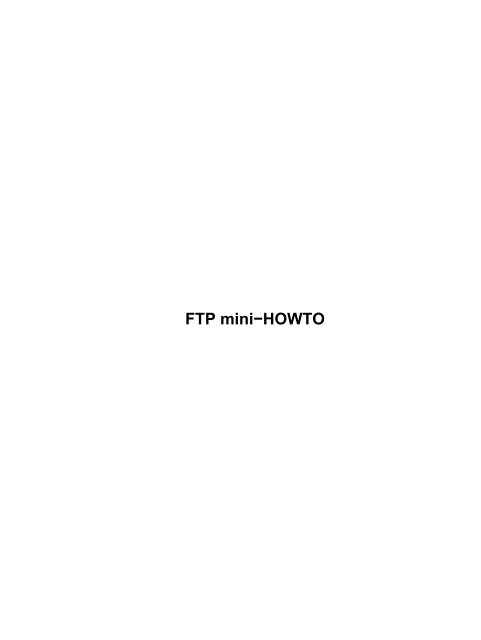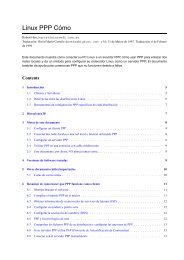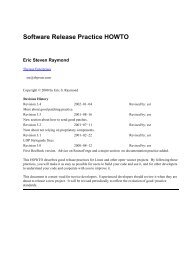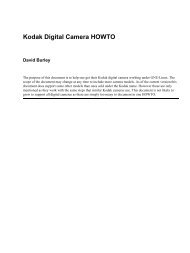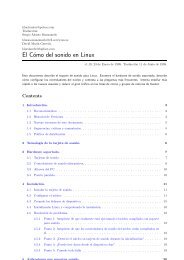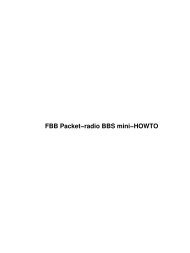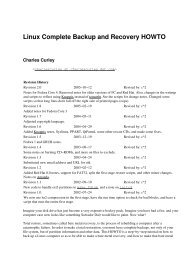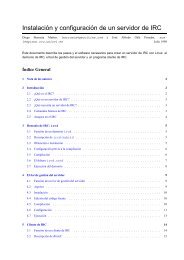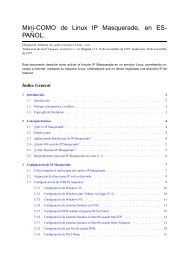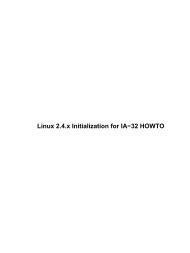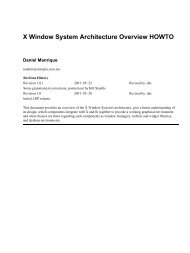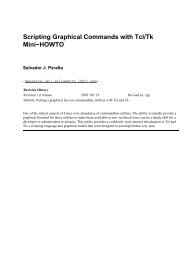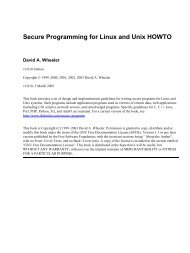FTP mini-HOWTO - The Linux Documentation Project
FTP mini-HOWTO - The Linux Documentation Project
FTP mini-HOWTO - The Linux Documentation Project
Create successful ePaper yourself
Turn your PDF publications into a flip-book with our unique Google optimized e-Paper software.
<strong>FTP</strong> <strong>mini</strong>−<strong>HOWTO</strong>
<strong>FTP</strong> <strong>mini</strong>−<strong>HOWTO</strong>Matthew Borowski ( mkb@yahoo.com )( http://tarp.worldserve.net/ )v0.2, 9 January 2000How to use ftp clients and servers1. Preamble• 1.1 Contacting Me• 1.2 Legalities and Distribution• 1.3 History of this document2. About <strong>FTP</strong>3. Beginner's guide to using ftp• 3.1 Running the ftp program• 3.2 Logging into an <strong>FTP</strong> server• 3.3 File transfer types• 3.4 Navigating and listing directories• 3.5 Downloading and uploading files• 3.6 Running shell commands• 3.7 Hash marks and tick• 3.8 Other ftp commands4. Console <strong>FTP</strong> clients• 4.1 Nc<strong>FTP</strong>• 4.2 lukemftp• 4.3 lftp• 4.4 cftp• 4.5 yafc5. X Window <strong>FTP</strong> clients• 5.1 g<strong>FTP</strong>• 5.2 WXftp• 5.3 LLNL XDIR and X<strong>FTP</strong>• 5.4 guiftp<strong>FTP</strong> <strong>mini</strong>−<strong>HOWTO</strong> 1
<strong>FTP</strong> <strong>mini</strong>−<strong>HOWTO</strong>200 PORT command successful.150 Opening BINARY mode data connection for linux−2.2.13.tar.gz (15079540bytes).<strong>The</strong> ftp program has started saving the remote file linux−2.2.13.tar.gz as the local filelinux−2.2.13.tar.gz.If you wanted to save it as the local file foo.tar.gz, you could have specified it like this:ftp> get linux−2.2.13.tar.gz foo.tar.gzlocal: foo.tar.gz remote: linux−2.2.13.tar.gz200 PORT command successful.150 Opening BINARY mode data connection for linux−2.2.13.tar.gz (15079540bytes).If you want to download more than one file at a time, you'll have to use the mget (multiple get) command.You can use mget together with a space−delimited list of filenames you want to download, or you can usewildcards with the mget command. For example:ftp> mget linux*Would get all files starting with the string "linux". Normally, mget will prompt you for each file before itdownloads it. You can toggle this by using the prompt command.Now let's say you've written a piece of software, and you want to upload it to MetaLab to be included in their<strong>Linux</strong> software archive. First, you'd change to the /incoming directory (most public <strong>FTP</strong> servers have adirectory, usually called incoming or uploads, where files can be uploaded), then you'd use the put command:ftp> cd /incomingftp> put foo.tar.gzlocal: foo.tar.gz remote: foo.tar.gz200 PORT command successful.150 Opening BINARY mode data connection for foo.tar.gz.226 Transfer complete.10257 bytes sent in 0.00316 secs (3.2e+03 Kbytes/sec)<strong>The</strong> put command works the same way as the get command, so you can use mput to upload multiple filesat the same time. You can also upload a local file with a different filename on the server by specifying theremote filename and/or pathname as an argument.What if the file foo.tar.gz is not in your current local directory when you try to upload it? You canswitch local directories by using the lcd (local change directory) command:ftp> lcd /home/foo/Local directory now /home/foo3.6 Running shell commands<strong>The</strong> ftp client supports using the bang (!) to run local commands. For example, to get a listing of files in yourcurrent local directory, do this:ftp> !ls3.6 Running shell commands 5
<strong>FTP</strong> <strong>mini</strong>−<strong>HOWTO</strong><strong>The</strong> way this works is that ftp calls the shell (specified in the $SHELL environment variable), and it is theshell which runs ls. Thus, you can run any command−line which works with your shell simply byprepending "!" to it (the default shell in most <strong>Linux</strong> distributions is bash, the Bourne Again SHell). Pleasenote that !cd does not work as you would expect, this is why the lcd command exists.3.7 Hash marks and tickWouldn't it be nice if you could watch the progress while you're downloading a file with ftp? You can use thehash command to print out hash marks as you download a file:ftp> hashHash mark printing on (1024 bytes/hash mark).As you can tell, ftp will print a hash mark for every 1024 bytes of data you download.<strong>The</strong>re is also a tick option.ftp> tickTick counter printing on (10240 bytes/tick increment).This will print something to this effect as you download a file:Bytes transferred: 116803.8 Other ftp commands<strong>The</strong>re are many other ftp commands. If you have the permissions to do so (which you should, if you areconnected to your own private shell account), you can make a directory on the remote server using themkdir command. You can remove a file on the remote server using the delete command, or rmdir toremove a directory. You can also change file permissions using the chmod command.For more elaborate information on using ftp, please see the online help in the ftp program (accessible bytyping help with no arguments for a list of commands, or help for specific help on acommand). You can also read the Unix man page for ftp by typing man ftp at your command prompt.4. Console <strong>FTP</strong> clients<strong>The</strong> original ftp program was the original ftp client, and it is a good investment to learn it. It's the only ftpclient that you can be certain is available on most systems (even Win32 comes with the ftp command, albeitan archaic, braindead version of it).<strong>The</strong>re are many other console−mode (text−only) ftp clients available. <strong>The</strong> listing here is by no meanscomprehensive, but includes the most popular ones. Search at FreshMeat to find more.4.1 Nc<strong>FTP</strong>Nc<strong>FTP</strong> is the all−time favorite ftp client of many Unix users. It comes bundled with most <strong>Linux</strong> distributions,and offers many advanced features such as tab completion and bookmarks. Version 2 of Nc<strong>FTP</strong> had a cursesbased full−screen mode. This was done away with in Version 3 (now in beta).3.7 Hash marks and tick 6
<strong>FTP</strong> <strong>mini</strong>−<strong>HOWTO</strong>It's not 100% compatible with the commands that standard ftp uses. For example, get and put in Nc<strong>FTP</strong> actlike mget and mput do in standard ftp. So if you want to save a remote file as a different local filename, you'dhave to do get −z remotename localname. Thankfully, Nc<strong>FTP</strong> has a nice online help system to assist you inlearning the commands.You can get the latest version of Nc<strong>FTP</strong> at http://www.ncftp.com.4.2 lukemftpA port of the NetBSD <strong>FTP</strong> client to other systems, lukemftp derives its name from the author of most of theenhanced features, which include: command−line editing, command−line fetches of <strong>FTP</strong> and HTTP URLs(including via proxies), context−sensitive word completion, dynamic progress bar, IPv6 support,modification time preservation, paging of local and remote files, passive mode support (with fallback toactive mode), SOCKS support, TIS FWTK gate−ftp server support, and transfer rate throttling.I highly recommend lukemftp to users who don't want to change to anything drastically different from thestandard ftp client, but want more advanced features.You can get the latest version of lukemftp at ftp://ftp.netbsd.org/pub/NetBSD/misc/lukemftp/.4.3 lftplftp is a sophisticated command line based <strong>FTP</strong> client. Like bash, it has job control. It uses the GNU readlinelibrary for input, so you have command line completion and editing. lftp also has bookmarks, mirroringsupport, and can transfer several files in parellel.You can get the latest version of lftp at http://ftp.yars.free.net/projects/lftp/.Debian packages are available at ftp://ftp.freshmeat.net/pub/debs/lftp/.4.4 cftpComfortable <strong>FTP</strong> (cftp) is a full screen mode client. What it lacks in features, it makes up for in ease of use.You browse through the directories using the arrow keys and enter.You should be able to get the latest version of cftp at http://ftp.giga.or.at/pub/nih/cftp/.4.5 yafcYafc is a very nice ftp client, with features including directory cache, remote filename completion, aliases,colorized ls, recursive get/put/ls/rm, nohup mode transfers, tagging (queueing), multiple connections, proxysupport and more. It has support for Kerberos4 authentication.You can get the latest version of yafc from http://www.stacken.kth.se/~mhe/yafc/.Debian packages are available at http://members.home.com/decklin/experimental/.Redhat packages are available at http://lz.freeservers.com/linux/yafc.html.4.2 lukemftp 7
<strong>FTP</strong> <strong>mini</strong>−<strong>HOWTO</strong>5. X Window <strong>FTP</strong> clients<strong>The</strong>re are several graphical <strong>FTP</strong> clients designed to run on the X Window system. <strong>The</strong>se clients offer ease ofuse for users who are used to graphical environments, and sometimes offer versatile options that would behard to implement in a text−based ftp client.5.1 g<strong>FTP</strong>g<strong>FTP</strong> is an <strong>FTP</strong> client for X Windows written using Gtk. <strong>The</strong> interface has some similarities to the popularWS_<strong>FTP</strong> software commonly used on a certain unstable operating system.g<strong>FTP</strong> features simultaneous downloads, resuming of interrupted file transfers, file transfer queues,downloading of entire directories, ftp proxy support, remote directory caching, passive and non−passive filetransfers, drag−n−drop support, a very nice connection manager and more.If you are running Red Hat <strong>Linux</strong> and have the GNOME desktop installed, then you probably already haveg<strong>FTP</strong>. If not, you can download g<strong>FTP</strong> from its homepage at http://gftp.seul.org/.5.2 WXftpWXftp is an <strong>FTP</strong> client for the X Window System designed to be used mainly on <strong>Linux</strong> workstations. It iswritten using the WXWindows toolkit, so it can be compiled to use either Motif or GTK+It includes an intuitive user interface (much like WS_<strong>FTP</strong>), a session manager, on−line help, a progress bar,and moreCheck out WXftp's homepage at http://www.wxftp.seul.org.5.3 LLNL XDIR and X<strong>FTP</strong>LLNL X<strong>FTP</strong> was one of the first graphical <strong>FTP</strong> clients for <strong>Linux</strong>. It supports FXP (file transfer between tworemote hosts), and has a Motif based interface.More information is available at http://www.llnl.gov/ia/xdir_xftp/.5.4 guiftpGuiftp is a simple ftp client written with the GTK+ toolkit. It's good if you don't need many features and wanta simple, clean look.Guiftp's homepage is at http://www.altern.org/ldufresne/guiftp/.5. X Window <strong>FTP</strong> clients 8
<strong>FTP</strong> <strong>mini</strong>−<strong>HOWTO</strong>6. <strong>FTP</strong> Servers6.1 How an <strong>FTP</strong> Server worksA traditional <strong>FTP</strong> server is executed from inetd (the internet superserver daemon). <strong>The</strong> standard <strong>FTP</strong> port isport 21. When a user tries to log in, the <strong>FTP</strong> server uses a standard system call to check the user name andpassword against the entries in the system password file, or the NIS tables if you are using NIS. If the login iscorrect, the user is given access to the system.Anonymous <strong>FTP</strong> works differently. <strong>The</strong> user logs in with either the anonymous or the ftp username (this canbe defined in the config file). He is then given access to a directory tree that has been chroot()'ed. Thisensures that the user can not gain access to directory trees he is not authorized for. <strong>The</strong> chrooted directorytree usually contains a mock filesystem, with bin/, etc/, and lib/ directories. <strong>The</strong> files for download are usuallyput in the pub/ directory.<strong>The</strong> reason for a mock filesystem in an anonymous <strong>FTP</strong> tree is that the <strong>FTP</strong> daemon runs external commandsfor ls requests. You can also place additional programs in the bin directory, and a user can run them with theSITE command in his ftp client. For example, Red Hat's <strong>FTP</strong> includes the RPM command (for users to queryRPM packages on the site).Some <strong>FTP</strong> servers work differently. For example, some will allow user accounts to be set up independant ofthe system−wide password file (<strong>FTP</strong>−only accounts). Some servers (Pro<strong>FTP</strong>D and Nc<strong>FTP</strong>d for instance)have built−in ls commands and do not need a special directory tree within the chroot structure. Other ftpservers stray altogether from the standard ftp concept. <strong>FTP</strong>4ALL, for example, does not use systempasswords at all. It uses it's own user and group file, and has features such as upload/download ratio andcustomizable server messages.6.2 Help with <strong>FTP</strong> ServersWU−<strong>FTP</strong>DWU−<strong>FTP</strong>D is the ftp daemon included with many <strong>Linux</strong> distributions, including Red Hat and Caldera. Youcan learn more about WU−<strong>FTP</strong>D at http://www.wu−ftpd.org.<strong>The</strong> WU−<strong>FTP</strong>D FAQ can be found on the web at http://www.cetis.hvu.nl/~koos/wu−ftpd−faq.html.Pro<strong>FTP</strong>DPro<strong>FTP</strong>D is a powerful <strong>FTP</strong> server that includes Apache−style configuration, extensive support for virtualhosts, and internal ls.A complete command reference and downloads can be found at http://www.proftpd.org6. <strong>FTP</strong> Servers 9


